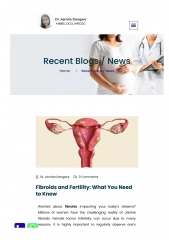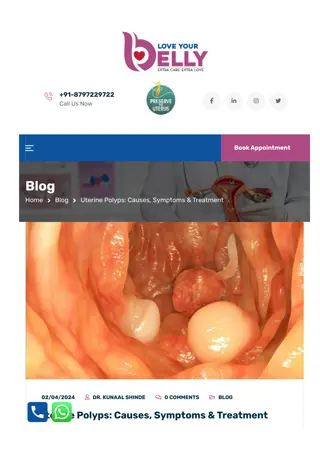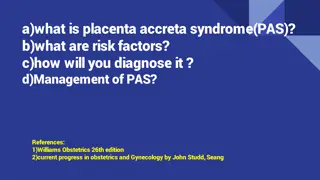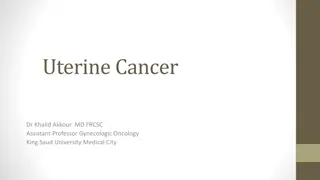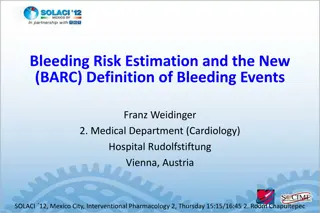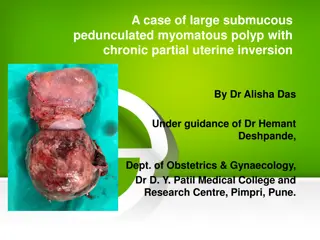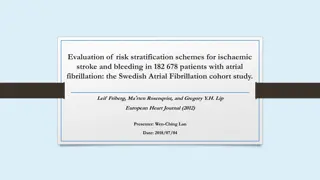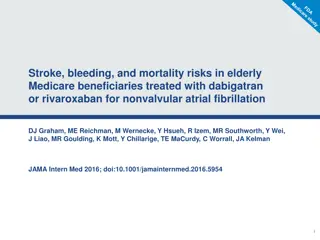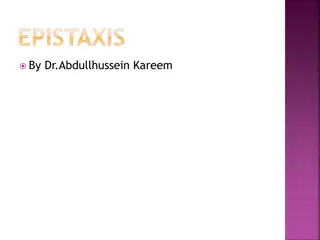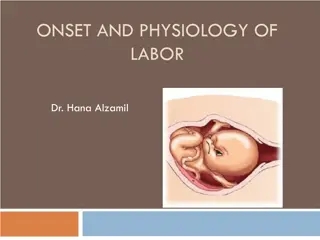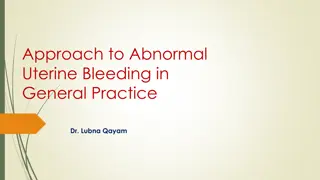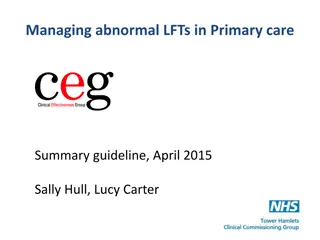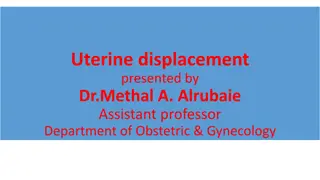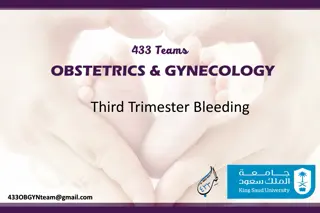Causes of Abnormal Uterine Bleeding and Systemic Diseases
Menstrual disorders and abnormal uterine bleeding (AUB) are common gynecologic complaints, with causes ranging from genital and nongenital tract diseases to systemic disorders and medications. Anovulation, hyperprolactinemia, thyroid disorders, and other factors can contribute to AUB. Complications of pregnancy, anovulation, anatomic defects, and coagulation defects are among the factors leading to irregular uterine bleeding. Hypothalamic anovulation, characterized by amenorrhea and inadequate luteal phases, is a key aspect to consider. Further classification of anovulation based on disorders of the hypothalamic-pituitary unit helps in understanding the underlying causes.
Download Presentation

Please find below an Image/Link to download the presentation.
The content on the website is provided AS IS for your information and personal use only. It may not be sold, licensed, or shared on other websites without obtaining consent from the author.If you encounter any issues during the download, it is possible that the publisher has removed the file from their server.
You are allowed to download the files provided on this website for personal or commercial use, subject to the condition that they are used lawfully. All files are the property of their respective owners.
The content on the website is provided AS IS for your information and personal use only. It may not be sold, licensed, or shared on other websites without obtaining consent from the author.
E N D
Presentation Transcript
ABNORMAL UTERINE BLEEDING AND SYSTEMIC DISEASES MS,Hosseini,Endocrinologist,Baqiatallah University of Medical Science
AGENDA Introduction Causes of AUB Hypothalamic Anovulation Hyperprolactinemia Thyroid disorders Androgen excess Kidney insufficiency Liver insufficiency AIDS Conclusion
INTRODUCTION Menstrual disorders and abnormal uterine bleeding (AUB) are among the most frequent gynecologic complaints. AUB may be caused by a number of genital and nongenital tract diseases, systemic disorders, and medications Caufriez A. Menstrual disorders in adolescence: pathophysiology and treatment. Horm Res 1991 Deligeoroglou E. Menstrual disorders during adolescence. Pediatr Endocrinol Rev 2006;
CAUSESOF IRREGULAR UTERINE BLEEDING Complications of Pregnancy Anovulation Anatomic Defects Affecting the Uterus Coagulation Defects Extrauterine Genital Bleeding
ANOVULATION Androgen excess PCOS, hyperthecosis Ovarian tumor (e.g., Sertoli- Leydig cell tumor) Nonclassic adrenal hyperplasia Cushing s syndrome Glucocorticoid resistance Adrenal tumor (e.g., adenoma, carcinoma) Medications (e.g., testosterone, danazol) Premature ovarian insufficiency (frequently presents as amenorrhea) Chronic illness Liver insufficiency Renal insufficiency AIDS Physiologic Uncomplicated pregnancy (amenorrhea) Pubertal (postmenarchal) anovulation Anovulation immediately before menopause Medications (e.g., oral contraceptives, GnRH agonists, danazol) Hypothalamic (frequently presents as amenorrhea) Functional (e.g., diet, exercise, stress) Anatomic (e.g., tumor, granulomatous disease, infection) Medications Hyperprolactinemia, other pituitary disorders Prolactinoma Other pituitary tumors, granulomatous disease Hypothyroidism Medications
HYPOTHALAMIC ANOVULATION Anovulation of hypothalamic origin usually manifests as amenorrhea It can take place gradually and may be characterized by inadequate luteal phases, irregular menstrual bleeding, and amenorrhea A reduction in GnRH pulse frequency leads to lower levels of LH and FSH secretion Haisenleder DJ. A pulsatile gonadotropinreleasinghormone stimulus is required to increase transcription of thegonadotropin subunit genes. Endocrinology. 1991
CLASSIFICATIONOF ANOVULATION CAUSEDBY DISORDERSOFTHE HYPOTHALAMIC-PITUITARY UNIT Functional Hypothalamic Anovulation (Amenorrhea) Stress (psychogenic or physical) Dieting Vigorous exercise Chronic illness (e.g., chronic liver or renal insufficiency, AIDS) Psychiatric-Medical Emergencies Anorexia nervosa Medications Antipsychotics (e.g., olanzapine, risperidone, amisulpride, clozapine), Opiates Hypothyroidism Anatomically or Genetically Defined Pathologies of the Hypothalamic-Pituitary Unit
FUNCTIONAL HYPOTHALAMICAMENORRHEA The overall prevalence of functional hypothalamic amenorrhea among all amenorrhea disorders ranges from 15% to 48% o In patients with this disorder, diverse etiologic factors such as malnutrition or caloric restriction, depression, psychogenic stress, excessive energy expenditure related to exercise, or combinations of these disorders precede the onset of functional hypothalamic anovulation. Liu JH. Stress-associated or functional hypothalamic amenorrhea in the adolescent. Ann N Y Acad Sci. 2008;
CONT. This functional gonadotropin deficiency fails to provide adequate stimulation to the ovarian follicles, and the normal sequence of follicular growth, maturation, follicular selection, and ovulation becomes attenuated. Ovarian estradiol production remains low, and endometrial growth is reduced or arrested, resulting in a prolonged interval of amenorrhea Filicori M. Characterization of the physiologicalpattern of episodic gonadotropin secretion throughout thehuman menstrual cycle. J Clin Endocrinol Metab. 1986
DIAGNOSIS Patients with functional hypothalamic amenorrhea most commonly present with secondary amenorrhea The diagnosis of hypothalamic amenorrhea is one of exclusion. Women with functional hypothalamic amenorrhea typically have a normal body weight or are thin. A variety of emotional crises or stressful events preceding the onset of amenorrhea. o These women usually have normal secondary sexual characteristics.
CONT. LH, FSH PRL,TSH The progestin challenge test Measurement of the serum estradiol level is not necessary MRI
TREATMENT should be directed at reversal of the primary cause (e.g., stress management, reduction of exercise, correction of weight loss) If anovulation persists for longer than 6 months or if reversal of the primary cause is not practical, a low dose combination oral contraceptive is a reasonable replacement option. o Berga SL. Use of cognitive behavior therapy forfunctional hypothalamic amenorrhea. Ann N Y Acad Sci. 2006 o Soyka LA. The effects of anorexianervosa on bone metabolism in female adolescents. J Clin Endocrinol Metab. 1999
HYPERPROLACTINEMIA Prolactin Reproductive Function: short luteal phase, reduced central FSH and LH levels, decreased granulosa cells,decreased estradiol levels and ultimately, amenorrhea Attenuated gonadotropin secretion is a major determinant of ovarian dysfunction in these patients Clinical Features: Women with prolactinomas may present with primary or secondary amenorrhea, oligomenorrhea, menorrhagia, delayed menarche, or regular menses with a short luteal phase that may result in infertility Milenkovic L. Inhibition of gonadotropinhormone-releasing hormone release by prolactin from GT1 neuronal cell lines through prolactin receptors. Proc Natl Acad Sci USA 1994 .
ETIOLOGYOFHYPERPROLACTINEMIA Physiological Hypothalamic-pituitary stalk damage Pituitary Systemic disorders Pharmacological Anesthetics Anticonvulsant Antidepressants Antihistamines (H2) Antihypertensives Cholinergic agonist Catecholamine depletor, Dopamine receptor blockers, Dopamine synthesis inhibitor, Estrogens: oral contraceptives; oral contraceptive withdrawal, Neuroleptics/antipsychotics, Neuropeptides, Opiates and opiate antagonists
HYPERPROLACTINEMIAAND ESTROGEN The role of estrogen in causing hyperprolactinemia is controversial . Twelve to 30% of women taking higher estrogen- containing oral contraceptives may have a small increase in serum prolactin, but this finding is rarely an indication for therapy. Molitch ME2005 Medication-induced hyperprolactinemia. Mayo Clin Proc Luciano AA 1985 Hyperprolactinemia and contraception: a prospective study. Obstet Gynecol
ESTROGEN Estrogen, along with a progestin, can be considered as sole therapy in women who have lactotroph microadenomas causing hyperprolactinemia and hypogonadism but who cannot tolerate or do not respond to dopamine agonists and do not want to become pregnant or in women with hyperprolactinemia and amenorrhea due to antipsychotic agents
CONT. The serum prolactin concentration should be measured periodically in these patients. Estrogen should not be used as the sole treatment for lactotroph macroadenomas. Estrogen and progestin can be administered separately in low doses as they would be for the treatment of hypogonadism of any etiology, or estrogen can be administered in the form of an oral contraceptive
DIAGNOSISOF HYPERPROLACTINEMIA Can be stablished by :a single measurement of serum prolactin; a level above the upper limit of normal confirms the diagnosis as long as the serum sample was obtained without excessive venipuncture stress. Diagnosis and Treatment of Hyperprolactinemia: An Endocrine Society Clinical Practice Guideline.JCEM 2011
TREATMENT Outcome Bromocriptine (2.5-7.5 mg/day) Cabergoline (0.5-1 mg twice weekly) Microadenomas PRL normalized Menses resumed Macroadenomas PRL normalized Menses resumed 70 70 80 80 65 85 70 80 Webster J. Cabergoline Comparative Study Group. N Engl J Med. 1994
HYPOTHYROIDISM Reproductive manifestations: hypothyroidism may be associated with diminished libido and failure of ovulation Secretion of progesterone is inadequate, and endometrial proliferation persists, resulting in excessive and irregular breakthrough menstrual bleeding These changes may be due to deficient secretion of LH or pulse frequency and amplitude, or both Rarely, in primary hypothyroidism, secondary depression of pituitary function may lead to ovarian atrophy and amenorrhea o Fertility is reduced Casey BM. Subclinical hypothyroidism and pregnancy outcomes. Obstet Gynecol. 2005
DIAGNOSIS A strategy for evaluating the patient with suspected hypothyroidism involves a TSH determination If the suspicion of hypothyroidism is strong, if a goiter is present, or if central hypothyroidism is part of the differential diagnosis, an fT4 assay should be included
TREATMENT Treatment is almost always with levothyroxine The typical dose of levothyroxine, approximately 1.6 to 1.8 g per kilogram of ideal body weight per day
CONDITIONS THAT INCREASE LEVOTHYROXINE REQUIREMENTS Pregnancy Gastrointestinal Disorders Drugs That Interfere with Levothyroxine Absorption Drugs That Increase the Cytochrome P450 Enzyme (CYP3A4) Activity Drugs That Block T4-to-T3 Conversion Conditions That May Block Deiodinase Synthesis
DRUGS THAT INCREASETHE CYTOCHROME P450 ENZYME (CYP3A4) ACTIVITY Rifampin Carbamazepine Estrogen* Phenytoin Sertraline Drugs That Block T4-to-T3 Conversion * The changes in Tg and distribution volume make exact resolution of the cause of the increased levothyroxine requirement is uncertain Arafah BM. Increased need for thyroxine in women with hypothyroidism during estrogen therapy. N Engl J Med. 2001
HYPERTHYROIDISM Reproductive manifestations: The intermenstrual interval may be prolonged or shortened; menstrual flow is initially diminished and ultimately ceases In some patients, menstrual cycles are predominantly anovulatory with oligomenorrhea, but ovulation occurs in most patients. In those with anovulatory cycles, a subnormal midcycle surge of LH may be responsible. o In premenopausal women with thyrotoxicosis, basal plasma concentrations of LH and FSH are reportedly normal but may display enhanced responsiveness to GnRH Stagnaro-Green Al. JAMA. 1990 Stagnaro-Green A. Best Pract Res Clin Endocrinol Metab. 2004
CONT The increased rate of conversion of androgens to estrogenic may be the mechanism one mechanism for menstrual irregularities in women. Another likely mechanism for menstrual changes is the disruption in amplitude and frequency of LH/FSH pulses caused by thyroid hormone influences on GnRH signaling.
DIAGNOSIS The serum TSH level, is almost totally suppressed, and serum T4 and T3 levels are elevated
ANDROGENEXCESS PCOS, hyperthecosis Ovarian tumor (e.g., Sertoli-Leydig cell tumor) Nonclassic adrenal hyperplasia Cushing s syndrome Glucocorticoid resistance Adrenal tumor (e.g., adenoma, carcinoma) Medications (e.g., testosterone, danazol)
THEPREVALENCEOFANDROGEN-EXCESS DISORDERS 72.1% for PCOS 15.8% for idiopathic hyperandrogenism 7.6% for idiopathic hirsutism 4.3% for 21-hydroxylase-deficient nonclassic adrenal hyperplasia 0.2% for androgen-secreting tumors Carmine Eet al. Extensive clinical experience: relativeprevalence of different androgen excess disorders in 950 womenreferred because of clinical hyperandrogenism. J Clin Endocrinol Metab. 2006
DIAGNOSTICCRITERIAFORPOLYCYSTICOVARY SYNDROME
LABORATORY TESTSFORTHE DIFFERENTIAL DIAGNOSIS OF ANDROGEN EXCESS Initial Testing Total testosterone Prolactin Thyroid-stimulating hormone Further Testing Based on Clinical Presentation 17-Hydroxyprogesterone (8:00 a.m.) 17-Hydroxyprogesterone 60 min after intravenous ACTH Cortisol (8:00 a.m.) after 1 mg dexamethasone at midnight DHEAS Androstenedione Imaging of ovaries (transvaginal ultrasonography) Imaging of adrenals (abdominal ultrasonography, CT, MRI) Nuclear imaging after intravenous administration of radiolabeled cholesterol
TREATMENT Combined OCP Progesterone Metformin
NONCLASSICADRENALHYPERPLASIA Although deficiencies in 11 - hydroxylase and 3 - HSD may result in the disorder, defects in 21-hydroxylase account for more than 90% of cases The clinical presentation is almost identical to that of patients with PCOS Azziz R. Screening for21-hydroxylase-deficient nonclassic adrenal hyperplasia among hyperandrogenic women: a prospective study. Fertil Steril. 1999
DIAGNOSIS A baseline serum level of 17-hydroxyprogesterone should be obtained at 8:00 a.m In a patient with: Androgen excess who belongs to an ethnic group in which there is a high prevalence of non classical adrenal hyperplasia premature pubarche Androgen excess of early pubertal onset progressive hirsutism or virilization strong family histories of severe androgen excess
TREATMENT GLUCOCORTICOIDS: The goal: lower serum concentrations of adrenal precursors and androgens to slightly above the upper limits for normal women,without causing Cushing's syndrome. Dexamethasone, given as a bedtime dose of 0.25 to 0.75 mg, effectively suppresses ACTH secretion for much of the next day
TREATMENT In adult women with hyperandrogenism and untreated nonclassic CAH, glucocorticoid suppression in isolation rarely controls hirsutism, and additional antiandrogen therapy is often required (e.g., cyproterone acetate, spironolactone, flutamide together with an oral estrogen contraceptive pill). However, ovulation induction rates with gonadotropin therapy are improved after suppression of nocturnal ACTH levels with dexamethasone Williams Textbook of Endocrinology 12th Edition.page 528
ANDROGEN-SECRETING TUMORSOF THE OVARYAND ADRENAL Most androgen-secreting tumors arise from the ovary These ovarian tumors secrete large quantities of testosterone or its precursor, androstenedione Rapidly progressing symptoms of androgen excess suggest the presence of an androgen- producing tumor Elevated serum testosterone levels are characteristically associated with ovarian tumors. Kennedy L.. J Clin Endocrinol Metab. 1987
CONT.. Testosterone levels three times the upper-normal range and DHEAS levels higher than 8 g/mL have been used traditionally as guidelines to investigate further whether neoplasms of the ovary or adrenal are thesources of androgen excess. Virilization of recent onset and short duration warrants immediate investigation , even if testosterone and DHEAS levels are mildly elevated Friedman CI. Serum testosterone concentrationsin the evaluation of androgen- producing tumors. Am J Obstet Gynecol. 1985
CHRONIC KIDNEY DISEASE Menstruation may present various abnormalities, such as oligomenorrhea or menorrhagia, which may occasionally require hysterectomy. In some women, normal menses are restored after initiation of hemodialysis Holley JL. Gynecologic and reproductive issues in women on dialysis. American Journal of Kidney Diseases 1997
CONT It can be caused by decreased platelets or platelet activity and hyperprolactinemia Increased plasma prolactin levels may impair hypothalamic pituitary function The normal pulsatile release of gonadotropins is disturbed Handelsman DJ. Hypothalamic-pituitary-gonadal dysfunction in renal failure, dialysis and renal transplantation. Endocrine Reviews 1985 Steinkampf PM. Systemic illness and menstrual dysfunction. Obstet Gynecol Clin North Am 1990
TREATMENT Initial treatment goals for uremic women with sexual dysfunction include maximizing the delivered dose of dialysis and correcting the anemia of chronic renal failure. The administration of a progestin for 10 days each month to women with renal failure and chronic anovulation but normal serum estradiol will result in menses. Other therapies bromocriptine for those with hyperprolactinemia, and estrogen supplementation for women with low circulating levels of estradiol Ginsburg, ES. Reproductive endocrinology and pregnancy in women on hemodialysis. Semin Dial 1993. Hypermenorrhea in the young hemodialysis patient. Am J Obstet Gynecol 1973
LIVER INSUFFICIENCY Amenorrhoea is a recognised complication of all types of end stage chronic liver disease. o In some cases of autoimmune chronic active hepatitis, amenorrhoea occurs relatively early in the disease process, while in primary biliary cirrhosis menorrhagia is the predominant initial menstrual abnormality Powell D. Pregnancy in active chronic hepatitis on immunosuppressive therapy. Postgrad MedJr 1969 Steven MM. Pregnancy in chronic active hepatitis. Qj Med 1979 Stellon AJ. Increased incidence of menstrualabnormalities and hysterectomy preceding primary biliarycirrhosis. Br MedJ7 1986
CONT Hepatic production of vitamin K dependent clotting factors and fibrinogen can be slowed by a variety of diseases. Liver disease also modifies the degradation pathways for estrogens, leading to elevated estrogen activity in the serum The hormonal basis for the amenorrhoea is poorly understood, but probably involves hypothalamic- pituitary dysfunction. Jennings JC. Abnormal uterine bleeding. Med Clin North Am 1995 Penn I. Parenthood following renal and hepatic transplantation. Transplantation 1980
TREATMENT After successful orthotopic liver transplantation, women achieve normal menstrual function and fertility. The return of menses can occur in 2 or 3 months after transplantation. Successful pregnancy has been documented in patients with autoimmune chronic active hepatitis who are well controlled with immunosuppressive therapy Karagiannis A.Gonadal dysfunction in systemic diseases.Eur J Endocrinol,2005
COMBINED OCP ABSOLUTE CONTRAINDICATIONS < 6 weeks postpartum if breastfeeding Smoker over the age of 35 ( 15 cigarettes per day) Hypertension (systolic 160mm Hg or diastolic 100mm Hg Current or past history of venous thromboembolism Ischemic heart disease History of cerebrovascular accident Complicated valvular heart disease (pulmonary HTN atrial fibrillation, history of subacute bacterialendocarditis) Migraine headache with focal neurological symptoms Breast cancer (current) Diabetes with retinopathy/nephropathy/neuropathy Severe cirrhosis Liver tumour (adenoma or hepatoma) World Health Organization. Improving access to quality care in family planning: medical eligibility criteria for contraceptive use. 2nd ed. Geneva: WHO;2001
COMBINED OCP RELATIVE CONTRAINDICATIONS Smoker over the age of 35 (< 15 cigarettes per day) Adequately controlled hypertension Hypertension (systolic 140 159mm Hg, diastolic 90 99mm Hg) Migraine headache over the age of 35 Currently symptomatic gallbladder disease Mild cirrhosis History of combined OC-related cholestasis Users of medications that may interfere with combined OC metabolism World Health Organization. Improving access to quality care in family planning: medical eligibility criteria for contraceptive use. 2nd ed. Geneva: WHO;2001
ABSOLUTEANDRELATIVECONTRAINDICATIONS TOTHEUSEOF DMPA Absolute contraindications: pregnancy (known or suspected), unexplained vaginal bleeding, and current diagnosis of breast cancer . Relative contraindications include severe cirrhosis, active viral hepatitis, and benign hepatic adenoma The World Health Organization. Improving access to quality care in family planning: medical eligibility criteria for contraceptive use. 2nd ed. Geneva:WHO;2001
AIDS Amenorrhea is seen in approximately 25% of HIV-infected women Anovulation is seen in up to 50% of HIV-infected women Changes in menstrual function are three times as likely in anovulatory HIV-infected women compared with normally ovulating patients Early menopause has been reported in up to 8% of HIV-infected women Androgen levels are often reduced in HIV-infected women The mechanisms of androgen deficiency in HIV disease may be related in part to intra-adrenal shunting toward cortisol production and away from androgen production Clark RA. J Infect Dis. 2001;184:1325-1327. Grinspoon S. J Clin Endocrinol Metab. 1997
TREATMENTCONSIDERATIONS Treatment considerations for ovarian dysfunction are generally similar to that for immunocompetent individuals Treatment with the combined oral contraceptive pill may increase the risk of HIV shedding in the lower genital tract and there remains the possibility that contraceptive efficacy is affected by antiretroviral drugs and other medications For postmenopausal women with symptoms of estrogen deficiency, hormone replacement therapy should be considered. Nielsen H. 1999 Hypermenorrhea associated with ritonavir. Lancet Shah R. 2000 Women and HIV revisited ten years on. Int J STD AIDS Clark RA. 2000 Perimenopausal symptomatology among HIV-infected women at least 40 years of age. J Acquir Immune Defic Syndr


